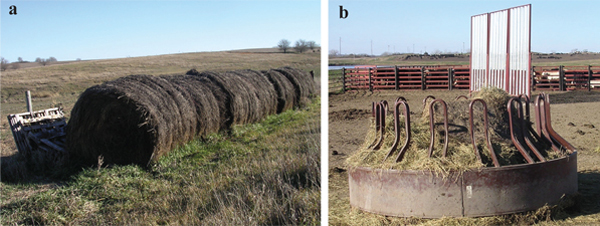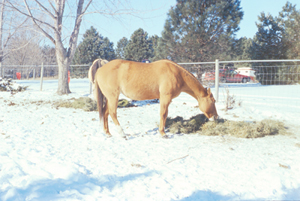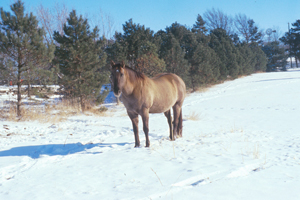G1873
Winter Care for Horses
Winter horse care is described in this NebGuide: energy requirements, feeding alterations, water requirements, hair and hoof implications, and shelter needs.
Kathleen P. Anderson, Extension Horse Specialist
- Effects on Energy Requirements
- Alterations in Feeding
- Water Requirements
- Hair Coat
- Shelter Requirements
- Hoof Care
|
||||||||||||
|
||||||||||||
As the weather turns cold, many horses are ridden less and less. It is easy to become relaxed in daily horse care since they are used less. However, horses still require much care and attention throughout the winter. Often, even greater attention is needed since there are no green pastures to graze or ponds and creeks from which to drink.
Effects on Energy Requirements
Falling temperatures, wind, and wet conditions cause a tremendous demand on the horse’s body for heat production. How much body condition a horse loses depends on the severity and duration of the cold season and the amount of energy the horse receives from its feed. As with all warm-blooded animals, horses must maintain their body temperature to survive. The environmental temperature and the heat produced within the body determine the extent to which heat must be conserved. The body does little to regulate heat generation and heat loss when the environmental temperatures are within ranges of the animal’s comfort zone or the “thermal neutral zone.” As environmental temperatures fall below the minimal temperature of the comfort zone or “critical temperature,” heat production is increased by the body by speeding up chemical reactions that produce heat.
The critical temperature can be used to estimate changes in a horse’s nutritional requirement relative to falling temperatures, cold winds, and wet hair coats. Estimates for the lower critical temperature for horses are between 30 and 50°F depending on hair coat, body condition, wetness, and windchill. The critical temperature for cattle ranges from 18°F for dry weather and heavy hair coats to 59°F for animals with summer or wet hair coats. Estimates for the lower critical temperatures for horses are given in Table I.
For each decrease in coldness of 1 degree Fahrenheit below the critical temperature, there is an increase in digestible energy requirements of 1 percent for body temperature maintenance (Table II). The best estimate of coldness is windchill temperature as this combines the effect of temperature and wind. For example a horse with a heavy winter hair coat has an estimated critical temperature of 30°F (Table I). Thus, if the wind chill is 20°F, the horse would have an increased energy requirement of 10 percent or 2 Mcal/day, and should consume approximately 2 additional pounds of hay per day (Table II). This 1,000 lb horse already should be consuming approximately 15 lb of hay per day, and now should consume 17 lb of hay to avoid any loss of body condition. Wet weather combined with wind greatly increases a horse’s energy needs (Table III). A horse in 32°F weather, without shelter and subjected to rain and 10 to 15 mph wind, would need to consume an additional 10 to 14 Mcal/day or a total of at least 25 lb of feed. Some horses would be unable to consume this volume of feed in hay alone.
| Table III. Effect of wind and rain on digestible energy requirement for horses at maintenance | |||
Average Temperature |
Additional Mcal/d |
Additional Hay |
|
32°F 32°F 32°F |
10-15 mph wind rain rain and wind |
4-8 Mcal/day 6 Mcal/day 10-14 Mcal/day* |
4-8 lb/day 6 lb/day 10-14 lb/day |
| *May be unable to consume enough hay to meet requirements. | |||
Alterations in Feeding
|
Many adult horses can maintain body condition on a complete forage diet with access to free choice trace mineralized salt. Adult horses should consume between 1.5 and 2 percent of their body weight in hay or a 1,000 lb horse will eat 15 to 20 lb of hay per day. Supplementation with grain is necessary only if horses have difficulty in maintaining body condition. Therefore, horses maintained in extremely cold conditions for an extended period with minimal shelter may need grain supplementation to meet their energy demands.
In most cases, an all-forage diet is a more desirable way to meet a horse’s elevated energy requirements. Forages contain a much higher fiber content than do grains. Fiber is utilized through bacterial fermentation within the cecum and large intestine. Much more heat is produced in bacterial fiber fermentation than in digestion and absorption of nutrients within the small intestine (cereal grains). This results in a greater amount of heat being produced through the utilization of forages than utilization of grain. Thus, a horse’s increased energy requirements are better met by providing horses all the forage a horse will consume without wastage (Figure 1).
Although winter conditions will greatly increase some horse’s energy requirements, the duration of the cold, windy, wet conditions should be considered before alterations are made in the feeding program. The amount of a ration (grain) a horse is fed cannot suddenly be adjusted without increased risk of colic and laminitis (founder). Horses should be preconditioned by gradual increases in the amount of energy fed per day (Figure 2a and 2b). Increases in hay are much more readily tolerated by horses. If the cold spell lasts only one to two days, alterations in grain may be unneeded. However, if the cold spell is over an extended period of time, adjustments may gradually be made.
 |
| Figures 2a and 2b. Round bales are one option for simplfied winter time forage feeding. |
Preconditioning horses before the onset of cold temperatures helps to reduce the effect of cold weather on nutritional needs. Fat cover acts as an insulator and provides energy reserves during stress. It may be difficult for horses to increase body condition during extremely cold weather. Additionally, during long bouts of freezing temperatures, most horses will experience some loss of body condition, no matter how well they are fed.
Water Requirements
Horses tend to reduce their water intake as temperatures fall. This reduced water intake, combined with increased forage consumption can lead to a greater incidence of impaction and colic. Water should be maintained between 45 and 65°F and any ice crystals should be removed. Water should be checked twice daily and provided at all times, as horses will drink 8 to 12 gallons a day. Forcing a horse to consume moisture by eating snow is counterproductive. Six times as much snow must be eaten to provide an equal amount of water. Furthermore, calories are used to melt the snow that should be used for body warmth.
Hair Coat
A heavy winter hair coat is a horse’s first defense from the cold. When allowed to grow, a horse’s natural hair coat acts as a tremendous insulator and provides as much warmth as the best blankets. Horses that are to be maintained outside should be allowed to grow a long hair coat, plus the hair within the ears and around the fetlocks should not be clipped throughout the winter months. Cold weather causes the hair to stand up, trapping and retaining body heat. Once the hair coat becomes wet, the hair lies down and loses its insulating ability. A long, fuzzy hair coat can be deceiving of a horse’s true body condition. The most accurate assessment of body condition is done through feeling the condition over the horse’s ribs, plus visual inspection of overall condition.
Shelter Requirements
|
Although stalling is unnecessary for all horses, some protection from the winter elements is desirable. Horses acclimate to winter conditions extremely well but need to be able to escape the bitter winds and moisture. A small, three-sided shed or timberline is sufficient shelter for pastured horses (Figure 3). This will enable them to minimize the effects of strong winds and snow or ice. The net effects are that horses will require less feed, can more easily maintain body weight, and are less stressed. These effects make the cost of sheds and windbreaks more attractive by reducing feed bills and reducing stress-related sickness.
If a three-sided shed is used, the open side of the shed should be opposite the prevailing wind. Each mature horse should have at least 80 square feet. The back wall should be 9-feet high, and the opening needs to be 11- to 12-feet tall. A 4- to 6-foot overhang will help prevent rain and snow from blowing into the shed. Sheds should be located so they have adequate drainage. If horses are to be indoors throughout the winter, stalls must be cleaned daily and bedding kept dry. Good ventilation is crucial. Damp stalls, ammonia buildup, and poor ventilation all contribute to respiratory problems. Horse owners will have much less labor, and at times healthier horses, if they are turned out during the winter months.
Care should be taken when leaving younger, less experienced horses on winter pasture. Running an older horse as a “baby sitter” can help teach the youngsters how to find shelter, food, and water. Additionally, the “baby sitter” often has a calming effect on the young herd and reduces the chances of them running through fences and such.
Hoof Care
Hoof care must be kept on schedule throughout the winter. Many horse owners prefer to “pull” shoes throughout this period of minimal riding. Any horse to be maintained outdoors in winter should have its shoes removed. A horse with shod feet can become ice packed, increasing the chance for slipping on snow and ice. Hooves should be routinely trimmed every six to eight weeks to prevent cracks and breakage. However, care should be taken not to trim them too closely to prevent bruised, sore feet from the frozen ground. Laminitis (founder) can occur from trauma to the sole due to walking on rough, frozen ground. Occasionally, if hooves are not maintained throughout the winter and allowed to break off, it may be difficult to have the horse shod when spring comes.
Caring for horses over the winter months can be a difficult task with cold weather, frozen water, and strong winds. However, the better horses are maintained during the winter, the better condition they will be in once the weather warms and it is time to start riding again. No matter how difficult the weather, providing feed, water, and shelter for horses is critical.
This publication has been peer reviewed.
Visit the University of Nebraska–Lincoln Extension Publications Web site for more publications.
Index: Horse
Management
Issued July 2008

